Extrusion Blow Molding
In extrusion blow molding the resin is melted in an extruder. The preform is made by extruding a tube of material out a die that is similar to the type of die used to make tubing, blown film, or any other cylindrical extruded shape. In the case of extrusion blow molding, the tube is called a parison and can be thought of as a preform that will later be blown into the final shape. To minimize the effects of gravity, the parison is extruded vertically downward.
As the parison descends, the two-part mold closes on it (illustrated in Figure 13.1). In step two, the top and bottom of the parison tube are pinched off between the faces of the mold. At the top, the pinch-off area surrounds the air inlet tube so that the air inlet tube extends below the pinch-off area. In some configurations, the air inlet tube is at the bottom, but more commonly it is at the top, as shown in the figure. Finally, a blast of air is introduced through the air inlet tube and the parison is blown outward against the walls of the mold cavity. The cold walls of the mold cool and solidify the part. The mold then opens and the part is ejected.
One problem in extrusion blow molding is caused by the continuous nature of the extrusion process. If during the time that the part is cooling in the mold the extruder continues to run, parison material will be extruded onto the top of the mold. This is obviously unacceptable and so some way must be found to either stop the extruder intermittently or to move the mold out of the way so that the new parison can descend without interference from the mold.
13.2.1. Intermittent Extrusion Blow Molding
The simplest way to solve the problem of interference between the parison and the mold is to stop the extrusion of the parison while the part is cooling in the mold. This method, called intermittent extrusion blow molding, uses machines that are much like a reciprocating injection molding machine, so this process is also called the reciprocating screw system. As the extruder screw turns to melt the resin, the screw retracts, thus creating a pool at the end of the extruder screw. When the parison is to be formed, the extruder screw simply moves forward and injects the resin through the die into the shape of the parison. This method is quite common for parts that cool quickly and when the shot size, that is, the total amount of material used in the parts for each cycle, is not great.
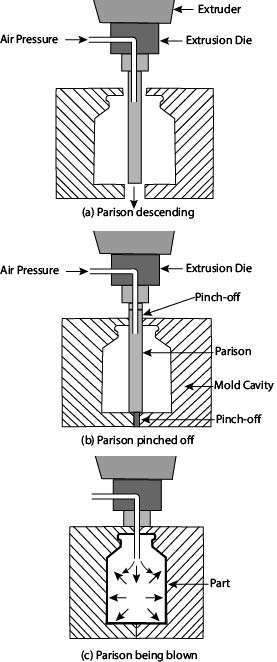

Intermittent extrusion blow molding can also be done simply by stopping the turning of the screw for the period of time that the part is cooling in the mold. Although conceptually simple, this method does not give the control over injection that can be obtained with the reciprocating molding machine and is, therefore, less commonly used.
13.2.2. Continuous Extrusion Blow Molding
The alternative to intermittent extrusion blow molding is continuous extrusion blow molding. Several methods have been devised that allow the extruder to run continuously and yet not cause interference between the mold and the new parison. One system uses an accumulator that receives the material from the extruder and then creates the parison as needed. Other systems involve moving the mold or the parison. These are called the rising mold system, the parison transfer system, and the multiple-mold system.
Accumulator Head or Ram Extrusion. In this system the extruder output flows into a reservoir that is external to the extruder itself. This system is shown in Figure 13.2.A ram, usually hydraulically driven, pushes the resin out of the reservoir and through the die that is mounted at the end of the accumulator to create the parison. The motion of the ram is tied to the mold cycle.
The accumulator head or ram extrusion system has a great advantage when very large, thick-walled parts are to be molded. The reservoir in most intermittent blow molding machines is not large enough to inject a large parison in one shot. If continuous blow molding is used and parison formation is linked to the extrusion screw speed, the parison is formed quite slowly and the weight of the parison is so great that it sags under its own weight. This can cause a distortion of the shape and wall thickness in the part. In the accumulator head system, the action of the ram can be rapid and therefore push the resin out so quickly so that the parison is formed, the mold closed, and the part blown before the parison has a chance to deform.
Some systems even use several extruders to feed the accumulator, thus further increasing the size of the parts that can be made. In most accumulators, the ram is lifted by the rising of the resin in the reservoir, thus eliminating air pockets in the accumulator that could lead to inaccuracies in the injection of the resin. The accumulator is heated to maintain the proper temperature of the resin, and so only resins with good heat stability should be used since the time that the resin may be at the high temperature could be quite long.

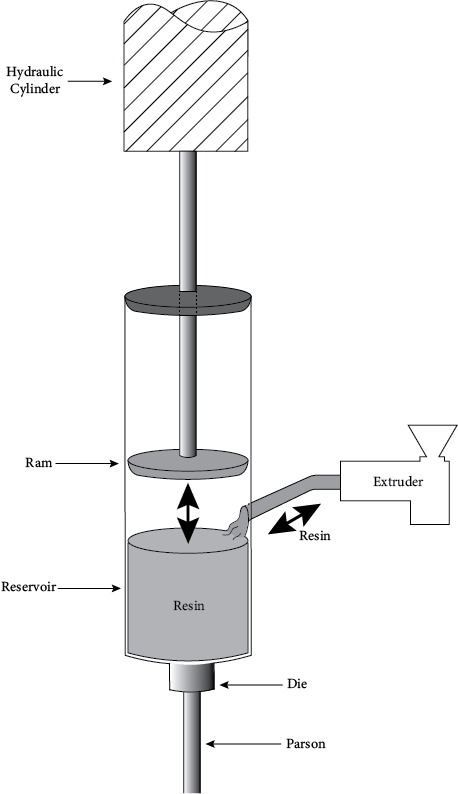
Figure 13.2 Accumulator system used in intermittent extrusion blow molding.
Rising Mold System. One way to both continuously extrude and also avoid interference between the parison and the mold is to remove the mold from below the extrusion die area. When the mold closes on the parison and air injection has occurred, the mold is moved off to the side. The pinching off of the mold creates a break point in the parison so that when the mold moves aside, the next parison is not disturbed. Because the cooling time in the mold is generally longer than the time required to extrude the next parison, the rising mold system usually requires at least two molds, which act in tandem. While one mold is cooling the part, the other mold has ejected its part and is open and moving into position to accept the next parison. This system is illustrated in Figure 13.3. With very long cooling times, more than two molds might be needed.
Parison Transfer System. In a system similar to the rising mold system, the parison is cut from the die by a knife and transferred by a mechanical arm to a mold where it is blown, cooled, and ejected. While this is occurring, other parisons are cut and transferred to other molds. This system, called the parison transfer system, is used rather than the rising mold system when the parts are quite large and the moving of large molds becomes mechanically difficult. This system is illustrated in Figure 13.4.

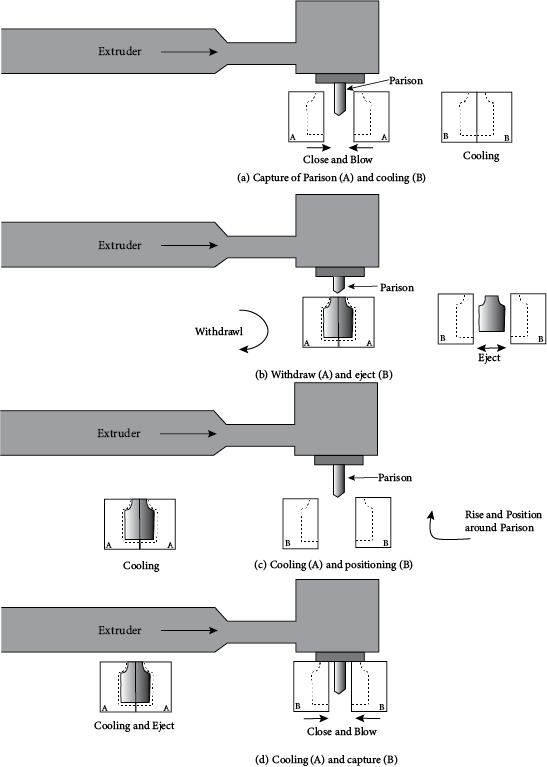
Figure 13.3 Rising mold system used in continuous extrusion blow molding.
Multiple-Mold System. Another continuous extrusion blow molding method uses a multiple-mold system to match the output of the extruder with the molding cycle. Several molds are mounted on a rotating wheel, as shown in Figure 13.5. While one mold is closing to capture the parison, the mold ahead is in position for blowing of the part, and other molds are closed while the part is cooling. Still farther around the wheel the mold opens for ejection of the part and in preparation for capturing another parison. In this system the rotational speed of the wheel and the number of molds mounted to the wheel are matched to the extruder output speed. Equivalent systems have been developed in which the wheel is mounted horizontally instead of vertically.
The major disadvantage of the rotating wheel versus the moveable mold system is that the rotating wheel is much more complicated mechanically and the cost of the system with all of the additional molds is quite high. The advantage of the rotating wheel versus the moving molds is that mold cycles that are much longer than the extrusion rate can be accommodated.
The continuous extrusion blow molding methods are best suited to high production of small to medium-size parts (up to about 8 gallons, 30 L). With small parts, the time to form the parison is short and the mold cycle is usually also short. Therefore, multiple molds can effectively be used to capture the parison and move it from the die area so that another mold can move into place. The system is limited, however, by the speed of the mechanical movement of the molds.

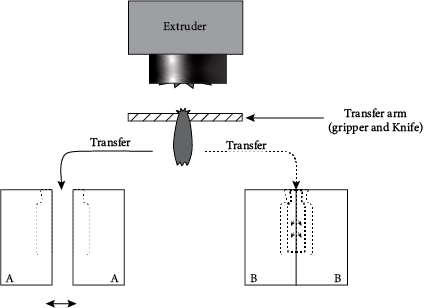
Figure 13.4 Parison transfer system for continuous extrusion blow molding.

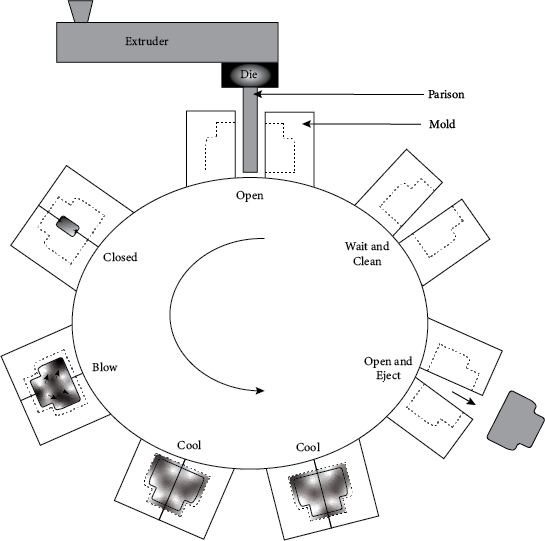
Figure 13.5 Rotating mold system used in continuous extrusion blow molding.